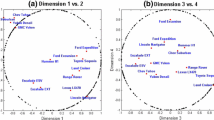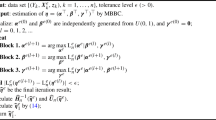Abstract
This paper develops a robust M estimation approach applied for three-dimensional (3D) correlated vector observations. A modified bifactor reduction model is constructed, where the weight shrinking factor of the 3D vector observation is determined by a new test statistic that coincides with the estimated direction of the outlier vector and thus is more sensitive to vector-type outliers than the standardized residual used for most conventional robust M methods. With the proposed bifactor reduction model, the outlying vector observation is down-weighted directly along a specific direction, rather than separately at the three components. The new equivalent weight matrix derived from the proposed bifactor model still keeps symmetry, based on which the parameter estimation procedure is developed. A real 3D control network of GNSS vector observations is processed by simulating outliers with different types, sizes and locations. The results show the effectiveness of the proposed approach by comparing with other four conventional robust M method (IGGIII, Danish, Huber and Hampel).








Similar content being viewed by others
References
Baarda W (1968) A testing procedure for use in geodetic networks. Neth. Geodetic Comm., Public. On Geodesy, New Series, 2(5): 1–60
Beaton AE, Tukey JW (1974) The fitting of power series, meaning polynomials, illustrated on band-spectroscopic data. Technometrics 16(2):147–185
Caspary W (1987) Concepts of network and deformation Analysis. Monograph 11, School of Geomatic Engineering, the University of New South Wales, Sydney
Caspary W, Borutta H (1987) Robust estimation in deformation models. Surv Rev 29(223):29–45
Duchnowski R (2010) Median-based estimates and their application in controlling reference mark stability. J Surv Eng 136(2):47–52
Duchnowski R (2013) Hodges-Lehmann estimates in deformation analyses. J Geodesy 87(10–12):873–884
Even-Tzur G (2001) Graph theory applications to GPS networks. GPS Solut 5:31–38
Even-Tzur G (2002) GPS vector configuration design for monitoring deformation networks. J Geodesy 76:455–461
Grafarend EW, Krumm F, Okeke F (1995) Curvilinear geodetic datum transformation. Zeitschrift für Vermessungswesen 120:334–350
Guo JF, Ou JK, Wang HT (2007) Quasi-accurate detection of outliers for correlated observations. J Surv Eng 133(3):129–130
Guo J, Ou J, Wang H (2010) Robust estimation for correlated observations: two local sensitivity-based downweighting strategies. J Geodesy 84(4):243–250
Hampel FR, Ronchetti EM, Rousseeuw PJ, Stahel WA (1986) Robust statistics, the approach based on influence functions. John Wiley, New York
Hekimoglu S, Berber M (2003) Effectiveness of robust methods in heterogeneous linear models. J Geodesy 76(11–12):706–713
Hodges JLJ, Lehmann EL (1963) Estimates of location based on rank tests. Ann Math Stat 34:598–611
Holland PW, Welsch RE (1977) Robust regression using iteratively reweighted least-squares. Commun Stat Theory Methods 6(9):813–827
Huber PJ (1964) Robust estimation of a location parameter. Ann Math Stat 35(1):73–101
Huber PJ (1981) Robust Statistics. Wiley, New York
Kargoll B, Omidalizarandi M, Loth I, Paffenholz JA, Alkhatib H (2018) An iteratively reweighted least-squares approach to adaptive robust adjustment of parameters in linear regression models with autoregressive and t-distributed deviations. J Geodesy 92(3):271–297
Khodabandeh A, Amiri-Simkooei AR (2011) Recursive algorithm for L1 norm estimation in linear models. J Surv Eng 137(1):1–8
Klein I, Matsuoka MT, Guzatto MP, de Souza SF, Veronez MR (2015) On evaluation of different methods for quality control of correlated observations. Surv Rev 47(340):28–35
Knight NL, Wang J (2009) A comparison of outlier detection procedures and robust estimation methods in GPS positioning. J Naviag 62:699–709
Knight NL, Wang J, Rizos C (2010) Generalised measures of reliability for multiple outliers. J Geodesy 84(10):625–635
Koch KR (1996) Robuste parameterschaetzung. Allgemeine Vermessungs-Nachrichten 103(11):1–18
Koch KR (2013) Robust estimation by expectation maximization algorithm. J Geodesy 87(2):107–116
Koch KR (2015) Minimal detectable outliers as measures of reliability. J Geodesy 89(5):483–490
Koch KR, Yang Y (1998) Robust Kalman filter for rank deficient observation models. J Geodesy 72(7–8):436–441
Koch IÉ, Veronez MR, da Silva RM, Klein I, Matsuoka MT, Gonzaga L, Larocca APC (2017) Least trimmed squares estimator with redundancy constraint for outlier detection in GNSS networks. Expert Syst Appl 88:230–237
Kok JJ (1984) On data snooping and multiple outlier testing. NOAA Technical Report NOS NGS. 30, US Department of Commerce, MD, USA
Krarup T, Kubik K, Juhl J (1980) Götterdämmerung over least squares. In: Proceedings of 14th congress of the international society of photogrammetry, Hamburg, Germany, vol B3, pp 369–378
Kutterer H (1998) Quality aspects of a GPS reference network in Antarctica-a simulation study. J Geodesy 72(2):51–63
Lehmann R (2012) Improved critical values for extreme normalized and studentized residuals in Gauss–Markov models. J Geodesy 86(12):1137–1146
Lehmann R (2013) On the formulation of the alternative hypothesis for geodetic outlier detection. J Geodesy 87(4):373–386
Leick A, Emmons MB (1994) Quality control with reliability for large GPS networks. J Surv Eng 120(1):25–41
Leick A, Rapoport L, Tatarnikov D (2015) GPS satellite surveying, 4th edn. Wiley, New York
Nie Y, Yang L, Shen Y (2019) Specific direction-based outlier detection approach for GNSS vector networks. Sensors 19:1836
Nowel K (2015) Robust M-estimation in analysis of control network deformations: classical and new method. J Surv Eng 141(4):04015002
Nowel K, Kamiński W (2014) Robust estimation of deformation from observation differences for free control networks. J Geodesy 88(8):749–764
Pope AJ (1976) The statistics of residuals and the detection of outliers. NOAA Technical Report NOS 65 NGS 1, U.S. National Geodetic Survey, MD, USA
Rousseeuw P (1984) Least median of squares regression. J Am Stat Assoc 79(388):871–880
Rousseeuw PJ, Wagner J (1994) Robust regression with a distributed intercept using least median of squares. Comput Stat Data Anal 17:65–75
Rousseeuw P, Yohai V (1984) Robust regression by means of S-estimators. In: Franke J, Härdle W, Martin D (eds) Robust and nonlinear time series analysis. Lecture notes in statistics, vol 26. Springer, New York
Saka MH (2016) Performance evaluation of outlier detection methods in GNSS vector networks using 1D and 3D component analysis. Measurement 82:145–150
Saleh J (2000) Robust estimation based on energy minimization principles. J Geodesy 74(3–4):291–305
Schaffrin B (1989) An alternative approach to robust collocation. Bull Géodésique 63(4):395–404
Snow KB (2002) Applications of parameter estimation and hypothesis testing to GPS network adjustments. Ohio State University, Division Geodetic Sci
Snow KB, Scharin B (2013) Three-dimensional outlier detection for GPS networks and their densification via the BLIMPBE approach. GPS Solut 7:130–139
Stigler SM (1977) Do robust estimators work with real data? Ann Stat 5(6):1055–1098
Teunissen PJG (2006) Testing theory; an introduction. Series on mathematical geodesy and positioning, 2nd edn. Delft University of Technology, Delft
Teunissen PJG (2018) Distributional theory for the DIA method. J Geodesy 92:59–80
Wieser A (2004) Reliability checking for GNSS baseline and network processing. GPS Solut 8:55–66
Wieser A, Brunner FK (2002) Short static GPS sessions: robust estimation results. GPS Solut 5(3):70–79
Wiśniewski Z (2009) Estimation of parameters in a split functional model of geodetic observations (M split estimation). J Geodesy 83:105–120
Wiśniewski Z (2010) M split (q) estimation: estimation of parameters in a multi split functional model of geodetic observations. J Geodesy 84(6):355–372
Wyszkowska P, Duchnowski R (2019) Msplit estimation based on L1 norm condition. J Surv Eng 145(3):04019006
Xu S (1987a) An F-T method for multiple outliers. J Wuhan Tech Univ Surv Mapp 12(02):41–46
Xu P (1987b) A test method for many outliers. ITC J 4:324–317
Xu P (1989a) On robust estimation with correlated observations. Bull Géodésique 63(3):237–252
Xu P (1989b) Statistical criteria for robust methods. ITC J 1:37–40
Xu P (1993) Consequences of constant parameters and confidence intervals of robust estimation. Bollettino di Geodesia e Scienze Affini 52(3):231–249
Xu P (2005) Sign-constrained robust least squares, subjective breakdown point and the effect of weights of observations on robustness. J Geodesy 79:146–159
Yang Y (1994) Robust estimation for dependent observations. Manuscripta geodaetica 19(1):10–17
Yang Y (1999) Robust estimation of geodetic datum transformation. J Geodesy 73(5):268–274
Yang Y, Xu J (2016) GNSS receiver autonomous integrity monitoring (RAIM) algorithm based on robust estimation. Geodesy Geodyn 7(2):117–123
Yang Y, Song L, Xu T (2002) Robust estimator for correlated observations based on bifactor equivalent weights. J Geodesy 76(6–7):353–358
Yang L, Shen Y, Lou L (2011) Equivalent weight robust estimation method based on median parameter estimates. Acta Geodaetica Cartogr Sin 40(1):28–32
Yang L, Wang J, Knight NL, Shen Y (2013) Outlier separability analysis with a multiple alternative hypotheses test. J Geodesy 87(6):591–604
Yang L, Shen Y, Li B, Rizos C (2017) Extension of internal reliability analysis regarding separability analysis. J Surv Eng 143(3):04017002
Yang L, Shen Y, Li B (2019a) M-estimation using unbiased median variance estimate. J Geodesy 93:911–925
Yang L, Nie Y, Shen Y (2019b) Characteristic analysis of 3D outlier detection method for GNSS network adjustments. J Surv Eng 145(4):04019014
Yohai VJ (1987) High breakdown-point and high efficiency robust estimates for regression. Annal Stat 15(2):642–656
Yu H, Shen Y, Yang L, Nie Y (2019) Robust M-estimation using the equivalent weights constructed by removing the influence of an outlier on the residuals. Surv Rev 51(364):60–69
Zaminpardaz S, Teunissen PJG (2019) DIA-datasnooping and identifiability. J Geodesy 93(1):85–101
Zienkiewicz MH (2014) Application of M split estimation to determine control points displacements in networks with unstable reference system. Surv Rev 47(342):174–180
Acknowledgements
This work is sponsored by the National Natural Science Foundation of China (41731069 and 41504022). The responsible editor and three reviewers are gratefully acknowledged for their constructive comments.
Author information
Authors and Affiliations
Contributions
L.Y. designed the research, processed data and wrote the paper draft. Y.S. proposed the key idea, supervised the research and revised the manuscript.
Corresponding author
Appendix
Appendix
The Danish method was proposed by Krarup (Krarup et al. 1980) and is purely heuristic with no rigorous statistical theory. The methods work by performing IRLS with the following weight shrinking function (Caspary 1987; Knight and Wang 2009)
The M estimators were first proposed by Huber (1964, 1981), and the weight reduction factor is given by
The shrinking factor for Hampel method is expressed as (Hampel et al. 1986)
The above three weight reduction functions are used for Danish, Huber and Hampel methods, respectively, in Sect. 4, to replace Eq. (9) for IGGIII methods. To applying these functions into correlated observations, bifactor reduction scheme of Eqs. (6)–(8) is always used (Figs. 9, 10, 11, and 12).
Cumulative distribution probability (CDF) of the test statistics \( \left| {\tilde{v}_{i} } \right| \) for conventional methods (a) and \( \left| {w_{il} } \right| \) for the proposed method (b) when an outlier vector with a size of σ, 2σ and 3σ is simulated at the baseline B2 to B13. (OF is for outlier-free case)
Rights and permissions
About this article
Cite this article
Yang, L., Shen, Y. Robust M estimation for 3D correlated vector observations based on modified bifactor weight reduction model. J Geod 94, 31 (2020). https://doi.org/10.1007/s00190-020-01351-1
Received:
Accepted:
Published:
DOI: https://doi.org/10.1007/s00190-020-01351-1








